On June 22nd, the Countway Library Smart Restart began. Our plan has been to proceed slowly with the health and safety of our staff front and center. To start, we have 4 teams consisting of 8-9 people who are scheduled for 2 4-hour shifts on site every 12 days. We have moved from Emergency Response mode to the Implementation Phase. I thought I would take this opportunity to tell you about the restart and how beneficial it has been for us to be onsite.
At present, nearly 1800 researchers are coming to campus, also in shifts. This does not include security guards, food service employees, facilities, and construction personnel in the buildings (including Countway). Some students returned to Vanderbilt Hall this week. A Longwood area viral testing site has been established at the NRB, and many of us went Wednesday, July 1st for baseline COVID-19 testing. Based on this pilot, testing may occur every Wednesday at this site.
Some highlights and stories from Countway staff who returned to work onsite are:
Signage, check-in, cleaning supplies
The library is ready with campus signage and additional signage for working in the stacks and separating construction and staff elevators and bathrooms. A check-in table with cleaning supplies and cleaning kits is located in Suite 219 and team captains are available to assist with any workspace problems. We ask staff to report any violations to your team captain. It’s inevitable someone will forget their facemask, but tell your captain, we have extras at the check-in table.

BML Inventory
We have made progress on the BML inventory! Ashley Thomas, RDMLA Librarian, has a great story to tell of an interesting item she found while working on the inventory. Check out her story with pictures below.
Written by: Ashley Thomas
Tuesday, June 23rd, 2020
As I am more of an archivist by training, I was naturally drawn to the older serials (because historical medicine fascinates and horrifies me in equal measures). So, I come across The Quarterly Bulletin of the Clinical Society of the New York Post-Graduate Medical School and Hospital, and having recently watched part of The Alienist on Hulu, I thought it would be interesting to scan through some antiquated medical thoughts.
I flipped through the book gently because the spine is detached (don't worry Len I made a note of it in the Excel sheet!) and first I see the picture of the poor patient - massive scar running across his skull. These pictures and article are from the late 1880s, the thought of any sort of cranial surgery is horrific (and riveting)—Did doctors even wash their hands back then?! The article regarding our poor scarred patient is on the next page, "A Successful Operation for the Extraction of a Pistol-Ball from the Brain Through a Counter-Opening in the Skull," by a pompous sounding middle-aged white man (assumption) named William F. Fluhrer, M.D., Professor of Clinical Surgery in the New York Post-Graduate Medical School and Hospital, Visiting Surgeon to Bellevue and Mt. Sinai Hospitals.
In my opinion, Dr. Fluhrer is a little too into this procedure, like his gusto for patients with gunshot wounds to the head is a little disconcerting. Anyway, Fluhrer starts off, mentioning how, when he was at the Ninety-ninth Street Hospital, a young man was brought in with a bullet wound to the skull. Fluhrer made observations of the trajectory and movement of the pistol-ball during his initial assessment, which he was then able to further observe and hypothesize once the patient died (because a GSW to the head in 1870s/1880s generally has one outcome). After digging around in the poor dead man's brain tissue, tracking the movement of the bullet, Fluhrer resolved that the next time he was presented with such a case, he was going to attempt to extract the bullet/promote healing through a counter opening in the skull.
Much to Fluhrer's (probable) elation, the young man in the photo became the next candidate.
I can't recall the patient's name, but how he ended up in Fluhrer's care is quite memorable. From my understanding, the young man had been attempting to complete suicide by holding a gun to the middle of his forehead. Unfortunately (fortunately?) the attempt was not fatal, but instead rendered him unconscious. After regaining consciousness our patient proceeds to walk, bloodied with a gaping head wound, approximately six blocks. He then hopped/stumbled on to a streetcar. I can imagine the other car passengers did the awkward shuffle away/side-eye move. Having only gone a few more blocks, our bloody pal caught the attention of the car conductor. When the conductor confronted the man, he was unable to communicate nor move very quickly (his right side, primarily his right arm, was paralyzed). The conductor removed the injured man from the streetcar, leaving him to stagger another six blocks until he came across a police officer. Again, because of the massive wound to his head, our patient was unable to move his right side properly and could not answer the officer's questions.
You'd think, at this point, seeing an individual, in obvious distress, blood everywhere wound to the forehead, the officer would take the man to a hospital. But no, this is the 1880s, it is better to drag the poor injured soul another x-number of blocks to the police station. Once there, the police proceeded to interrogate the man. While it appeared to the officers that the man wanted to answer their questions, he was unable to do so, because re: the bullet wound to his head. Mercifully, the young man lost consciousness again, and then (and only then) did the police decide to move our patient to Bellevue hospital.
So after literal hours, and having walked at least 16 New York City street blocks, the patient is eventually seen by dear ol' Dr. Fluhrer. After cleaning out the wound, Fluhrer decided to probe along the bullet's path using a metal rod, tracking the bullet ricochet, and eventually located in the patient's head. After viewing the image of the probe and reading a few sentences that contained words like tissue, moist, and soft, I stopped reading. (There is a reason the medical field never called to me.)
Having miraculously survived the operation (don't worry, they etherized him), Fluhrer took pretty careful notes of the man's slow recovery. Recovery of the movement of his right side came much quicker than the recovery of his short term memory, but after several weeks, the patient was pretty much recovered and went back to his life.
Unfortunately, because this dude has some really, really bad luck, his story doesn't quite end there. So our now mostly recovered friend works at a butcher shop, and one day, while at work, one of his co-workers proceeds (accidentally, I hope) to elbow him, hard, right on the healed bullet wound. Of course, this renders him unconscious. It also undoes a lot of the process he had made in regaining movement and memory. Our dude does recover (again), but not to the same degree as before. I believe he was still doing okay (or at least alive) by the end of the article. I don't quite remember, because l started to feel guilty for reading for over 20+ minutes.
In summary, humans are weird, nineteenth-century medicine is a nightmare, and in 1885/6, some guy survived a self-inflicted gunshot wound to the head.


Center for the History of Medicine
Center for the History of Medicine staff have also made progress and were able to resolve some problems and identify some others regarding BML ownership. They have been playing detective these weeks. Read below an update on onsite work.
Written by: Emily Novak Gustainis, Deputy Director, Center for the History of Medicine
June 30th, 2020
On June 22nd, after three months of being remote, Center for the History of Medicine staff were excited to return to campus and get back to hands-on work with Countway’s stellar primary resources on behalf of faculty, students, staff, and the general public. Being back onsite, connecting with both colleagues and collections, as well as working communally, was reinvigorating and a welcome change.
Jessica Murphy, Public Services Librarian, spent her first two days onsite answering reference questions that required access to original manuscripts, and she continued to work on a survey of incunables. She snapped these photographs of some of the incredibly rare volumes she worked with, including this page with rubrications (right) and another with a bookplate featuring the Tansteter coat of arms (left); both are from the Ballard collection. Jessica, Stephanie Krauss, and Dominic Hall are all working on supporting research, teaching, and learning activities for the Fall semester, including preparing content and scanning collections for remote learning.
Meghan Bannon Kerr, LMA Records Manager/Archivist, responded to requests from the Harvard Depository to verify whether or not certain HMS client accounts had been officially closed. Meg reviewed the paper control files for twenty HD client accounts and located letters from HMS departments, as well as reviewed and scheduled records from the HMS Office of Finance’s to ensure compliance. Meg also contributed to a review of photographs and prints in the portrait, picture, and subject collections. The survey work, which is being principally conducted by Charlotte Lellman, Processing Archivist, will physically separate and enumerate BML-owned items in graphic materials collections. Charlotte went through twenty-five boxes of portraits—including drawings, frontispieces, photographs, slides, and negatives—in under six hours, separating and tracking BML-stamped images as she went.
Hanna Clutterbuck-Cook, Processing Assistant, and Amber LaFountain, Metadata Archivist, worked on a Countway Collections Inventory Project-related survey of uncataloged and duplicate books in Center stacks. Hanna was delighted to come across books from the collections of Henry Bowditch and S. Weir Mitchell, but by far, her favorite find was a 1967 reprint of Francis Place’s 1822 Illustrations and proofs of the principle of population. Hanna reports that Place is a key figure in the history of English radicalism and the development not only of the English working class as a whole but also of organized labor as a concept.
Jessica Sedgwick and I continued to conduct provenance research for manuscript collections with an unknown ownership designation identified as part of the Countway Collections Inventory project. This included retrieving and reviewing collections for which little or no documentation exists. One collection I looked at consists of an audio reel and a cassette copy of an "Interview of Dr. Coolidge by Mr. Robert T. Morrison of the General Electric Research and Development Center, Schenectady, NY, 22 Oct. 1965.” In the folder are photographs of Walter T. Murphy, MD and Melvin C. Reinhart, MA, and numerous copy prints of photographs of roentgen and x-ray technologies in operation, many of them copies from the General Electric archives and hospitals from various US locations. The collection is a small addition to the Center’s robust radiology collections, including the papers of Harvard Medical School faculty John B. Little, whose research included radiation-induced genomic instability and the bystander effect of radiation; Sven Paulin, a recognized pioneer in cardiothoracic imaging; Morris Simon, inventor of the nitinol filter and stent, needle localizer, variable scale disc ruler, and rotary disc calculator; and Nancy J. Tarbell, a radiation oncologist who specializes in pediatric brain tumors.
While there is always plenty of critical work Center staff can do remotely, being able to walk through stacks of books, manuscripts, archives, and objects that span seven centuries of evolving medical, dental, and public health practice reminded me of why I became an archivist in the first place: the commitment to make the past inform the future and to preserve and collect evidence in the service of change.


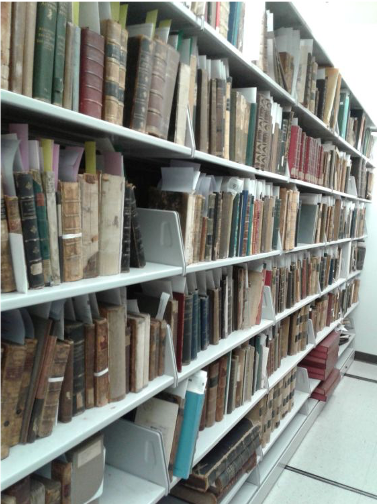
Anatomage Table
When the current phase of renovations to the Countway is complete, we will have a new maker space that will be on the 1st floor on the Chan plaza side of the building. One of the many innovative learning and creating tools we will have in that space is an Anatomage Table. The Anatomage Table is a full scale, 3D interactive, electronic dissection table that allows users to visualize a human cadaver as they would in a gross anatomy lab. In addition to the high-definition mages, the table comes with educational software to enhance anatomy education. The table was delivered on Tuesday and is now safely in storage until we can bring it up to 1, plug it in, and see this amazing teaching tool in action.

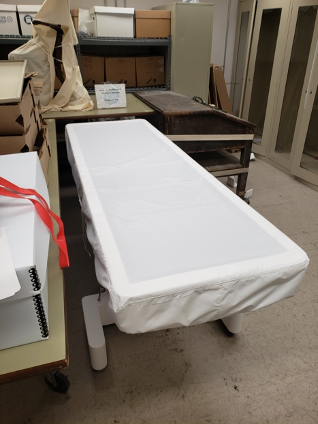
Mail, Supplies, and other Delivery
MJ and Len tracked down our WB Mason orders that were made before we left the site. The mailroom is delivering the mail and supplies, which are now finally arriving at Countway.
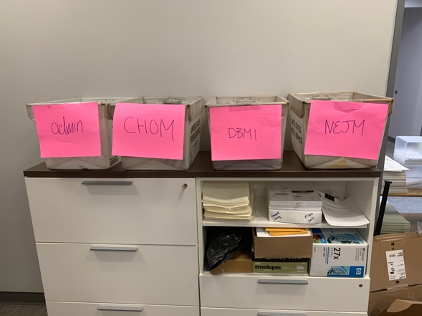
We found the book drop! It’s no longer hidden behind the dumpster.
The book drop has been relocated, emptied and the books are in 72-hour quarantine before they will be processed.
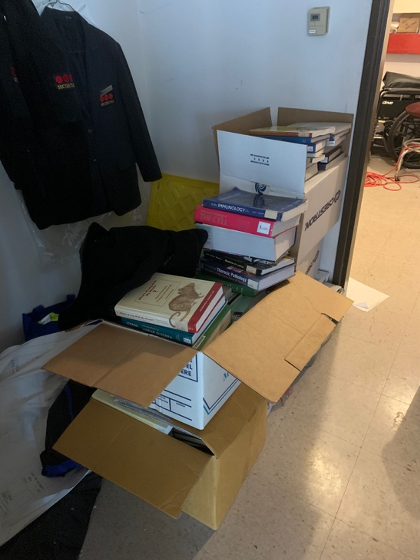
COVID-19 LMA testing site
On July 1st, MJ and I took our self-administered COVID-19 test. It was quick, easy, and NOT painful at all. We encourage everyone to do it! Check the Countway Facebook page for a video of the process, and please visit Harvard Health Publishing for more information.

Construction Update Newsletter and Staff on Track Communications resume
Now that Luciana and Meredith are back on site, the weekly communications meeting with the construction team has resumed and the newsletters will be coming to your email inboxes again each Friday and with pictures!
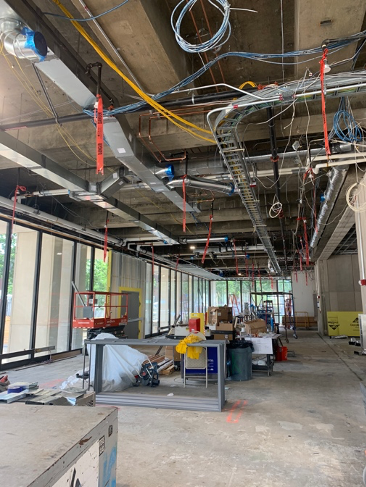
It’s been a busy two weeks with all teams going through their first work cycle. We are looking forward to hearing more stories and highlights from our onsite teams. The campus is slowly and carefully buzzing again.
Elaine